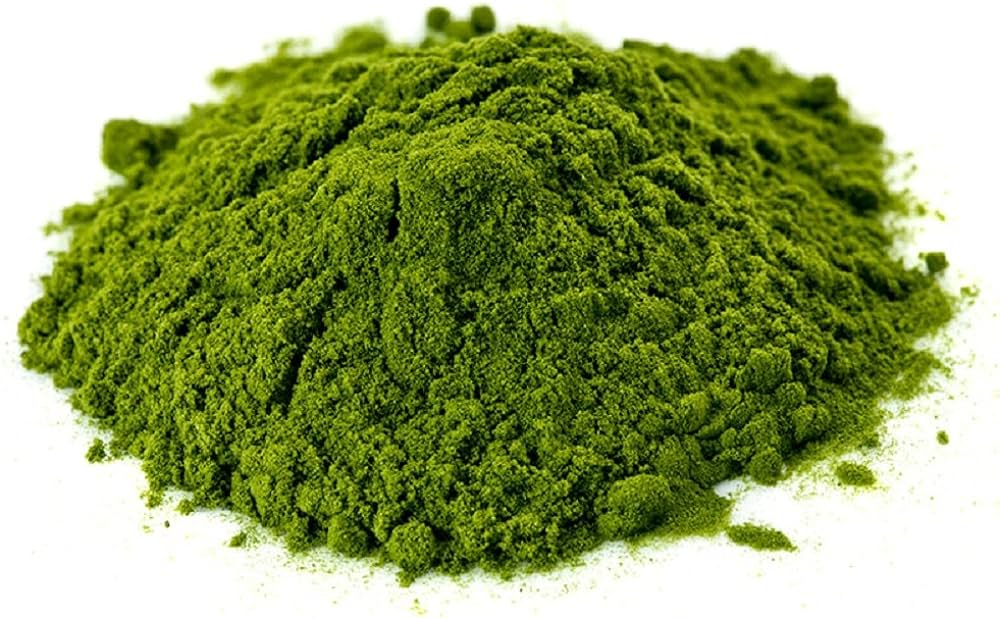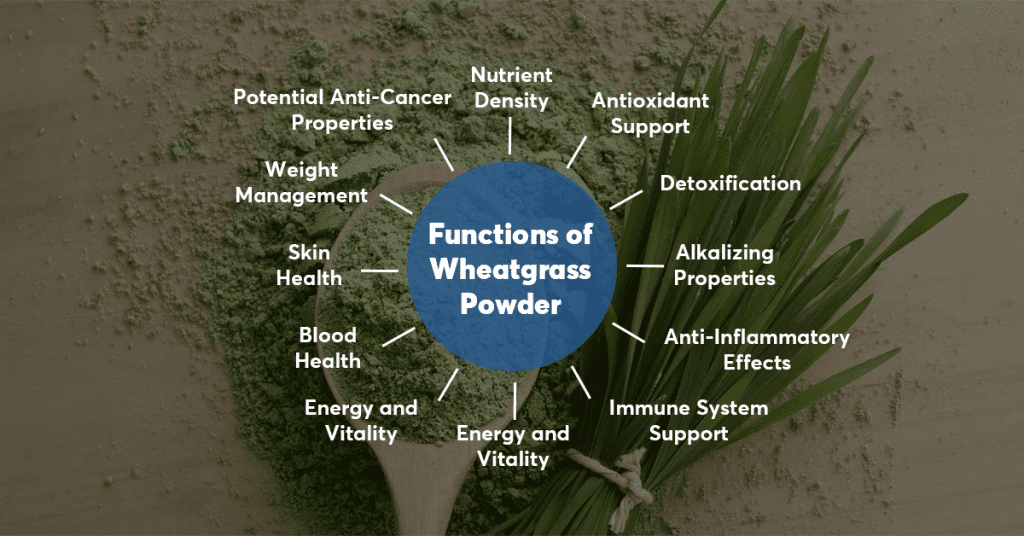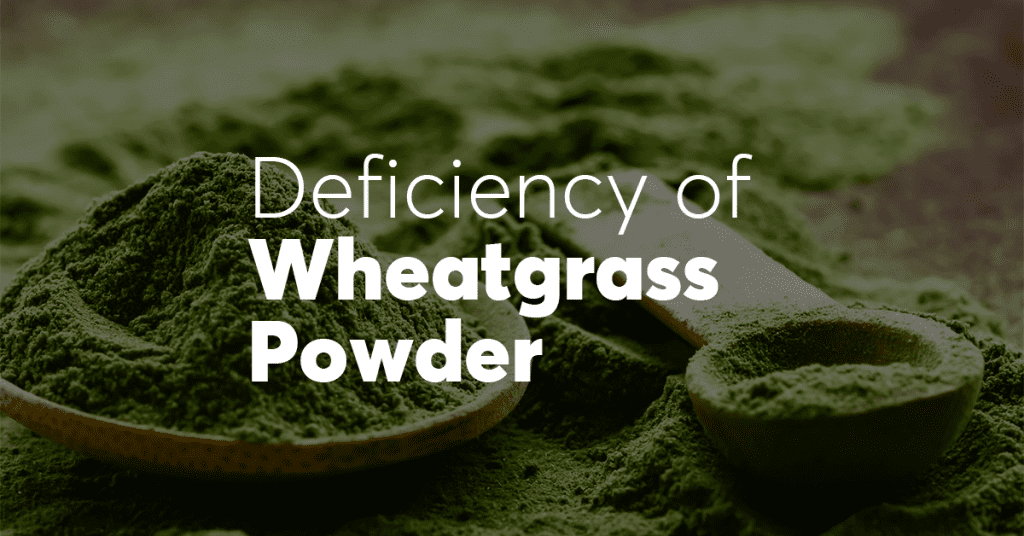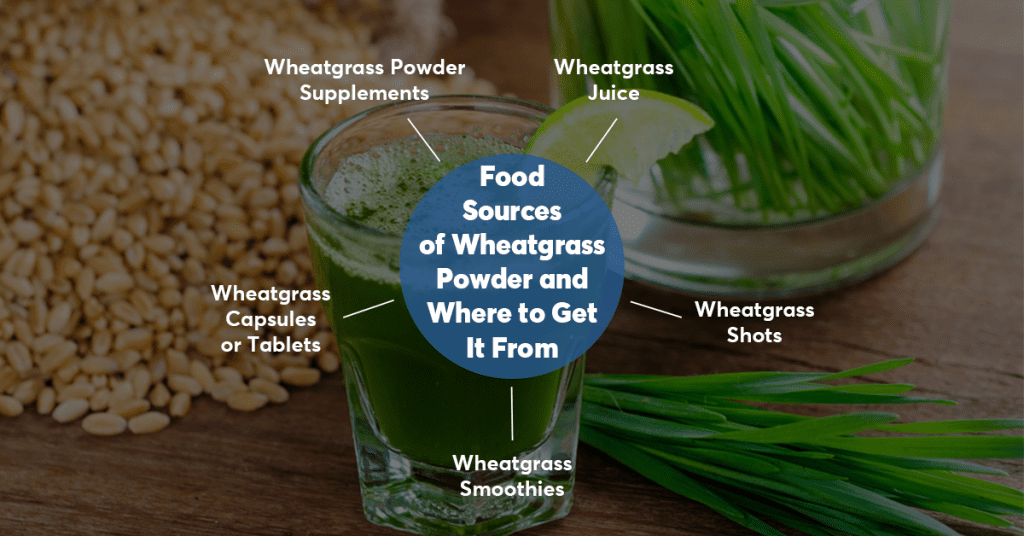
- Overview of Wheatgrass Powder
- Brief History of Wheatgrass Powder
- Functions of Wheatgrass Powder
- Recommended Daily Intake (RDI), Recommended Dietary Allowance (RDA), Adequate Intake (AI), or Reference Nutrient Intake (RNI) for Wheatgrass Powder
- Deficiency of Wheatgrass Powder
- Food Sources of Wheatgrass Powder and Where to Get It From
- Wheatgrass Powder and Its Interaction with Other Medications
- Websites and Articles to Delve into the Benefits of Wheatgrass Powder
- Disclaimer
Overview of Wheatgrass Powder
Wheatgrass powder is a concentrated source of nutrients derived from the young shoots of the wheat plant, Triticum aestivum.
Packed with vitamins, minerals, antioxidants, and chlorophyll, wheatgrass is celebrated for its potential health benefits. Rich in vitamin A, vitamin C, and vitamin E, as well as essential minerals like iron and magnesium, it supports immune function, aids detoxification, and exhibits antioxidant properties. Chlorophyll, the green pigment in wheatgrass, contributes to its alkalizing effects and potential anti-inflammatory benefits. Often consumed in powdered form, wheatgrass can be easily added to juices, smoothies, or water.
However, individual responses vary, and consulting healthcare professionals is advisable, particularly for those with allergies, sensitivities, or medical conditions. Incorporating wheatgrass into a balanced diet may enhance overall nutrition and well-being.
Brief History of Wheatgrass Powder
The use of wheatgrass for its potential health benefits dates back thousands of years to ancient civilizations, where young wheat plants were revered for their perceived medicinal properties. However, the popularity of wheatgrass powder as a concentrated dietary supplement gained traction in the 20th century.
The credit for popularizing wheatgrass in modern times is often attributed to Ann Wigmore, a Lithuanian-American holistic health practitioner. In the 1950s, Wigmore reportedly started using wheatgrass as part of her natural healing practices, promoting its consumption for detoxification and overall health.
Wigmore founded the Hippocrates Health Institute in Boston, where she incorporated wheatgrass into therapeutic regimens. She also advocated juicing wheatgrass to maximize its nutritional benefits. The institute and Wigmore’s teachings played a significant role in popularizing wheatgrass as a superfood.
Since then, wheatgrass has become a prominent component of the health and wellness industry. Wheatgrass powder, derived from the juiced and dried young shoots of the wheat plant, is now a widely available dietary supplement, celebrated for its nutrient-rich composition and potential health-promoting properties.
A brief history of wheatgrass powder presented in a tabular format:
| Time Period | Development of Wheatgrass Powder |
|---|---|
| Ancient Civilizations | Historical use of young wheat plants in traditional medicine for perceived health benefits. |
| 20th Century | Ann Wigmore, a holistic health practitioner, popularizes wheatgrass in the 1950s, incorporating it into natural healing practices. |
| 1950s Onward | Wigmore’s teachings and the founding of the Hippocrates Health Institute contribute to the modern popularity of wheatgrass for health and wellness. |
| Present Day | Wheatgrass powder becomes a widely available dietary supplement, valued for its nutrient-rich composition and potential health benefits. |
This table provides a concise overview of the key developments in the history of wheatgrass powder.
Functions of Wheatgrass Powder

Wheatgrass powder is renowned for its rich nutritional profile, containing vitamins, minerals, antioxidants, and chlorophyll. Here are some of the potential functions and benefits associated with wheatgrass powder:
- Nutrient Density:
- Wheatgrass powder is a concentrated source of essential nutrients, including vitamins A, C, E, and K, as well as minerals like iron, magnesium, and calcium.
- Antioxidant Support:
- Rich in antioxidants, including flavonoids and chlorophyll, wheatgrass helps combat oxidative stress and may protect cells from damage caused by free radicals.
- Detoxification:
- Chlorophyll, a prominent component in wheatgrass, is believed to have detoxifying properties, assisting the body in eliminating toxins and supporting liver function.
- Alkalizing Properties:
- Wheatgrass is alkaline-forming, potentially helping to balance the body’s pH levels and counteract acidity.
- Anti-Inflammatory Effects:
- Some studies suggest that wheatgrass may exhibit anti-inflammatory properties, contributing to overall health and well-being.
- Immune System Support:
- The vitamins and minerals in wheatgrass play a role in supporting immune function, helping the body defend against infections and illnesses.
- Energy and Vitality:
- Wheatgrass is often associated with increased energy levels and vitality, possibly due to its nutrient content.
- Digestive Health:
- Wheatgrass contains dietary fiber, which promotes digestive health, supports regular bowel movements, and may aid in maintaining a healthy gut microbiome.
- Blood Health:
- The iron content in wheatgrass supports red blood cell formation, potentially benefiting individuals with iron-deficiency anemia.
- Skin Health:
- Some users claim that wheatgrass contributes to improved skin health, possibly due to its antioxidant content and potential detoxification effects.
- Weight Management:
- Wheatgrass, as a low-calorie and nutrient-dense food, may contribute to weight management when included in a balanced diet.
- Potential Anti-Cancer Properties:
- While research is ongoing, some studies suggest that wheatgrass may have anti-cancer properties, including the ability to inhibit the growth of certain cancer cells.
It’s important to note that individual responses to wheatgrass can vary, and scientific evidence supporting some of these claims is still evolving. Before incorporating wheatgrass powder into your routine, especially if you have underlying health conditions or are taking medications, it’s advisable to consult with a healthcare professional.
Recommended Daily Intake (RDI), Recommended Dietary Allowance (RDA), Adequate Intake (AI), or Reference Nutrient Intake (RNI) for Wheatgrass Powder
Wheatgrass is typically consumed as a supplement rather than a primary source of essential nutrients, and its nutritional content can vary based on factors such as growing conditions and processing methods. It’s important to note that there are no established Recommended Dietary Allowance (RDA), Adequate Intake (AI), or Reference Nutrient Intake (RNI) values given for wheatgrass powder.
If you are considering adding wheatgrass powder to your diet, it’s essential to view it as a complementary source of nutrients rather than a sole provider. The best approach is to follow the recommended serving size provided by the product’s manufacturer or consult with a healthcare professional for personalized advice.
While wheatgrass powder is nutrient-dense and offers various potential health benefits, it’s important to obtain a wide range of nutrients from a balanced diet that includes a variety of whole foods. If you have specific dietary concerns or health conditions, consulting with a registered dietitian or healthcare professional is advisable for personalized guidance.
Deficiency of Wheatgrass Powder

Wheatgrass powder itself is not a nutrient but a concentrated form of the young shoots of the wheat plant, containing various vitamins, minerals, antioxidants, and other beneficial compounds. Therefore, a “deficiency” of wheatgrass powder is not a recognized concept. However, if someone is deficient in the nutrients that wheatgrass provides, it can lead to various health issues.
Nutrient deficiencies, such as lack of vitamins, minerals, or other essential compounds, can occur if an individual’s diet lacks diversity or is deficient in specific food groups. Wheatgrass, while nutritious, should be considered as a supplement and not a substitute for a well-balanced and varied diet.
If someone experiences symptoms of nutrient deficiencies, such as fatigue, weakness, skin issues, or impaired immune function, it’s crucial to address the overall diet and identify specific nutrient gaps. Consulting with a healthcare professional or a registered dietitian is advisable to develop a personalized nutrition plan that meets individual needs and ensures adequate intake of essential nutrients.
Food Sources of Wheatgrass Powder and Where to Get It From

Wheatgrass powder is typically derived from the young shoots of the wheat plant (Triticum aestivum). While the powder itself is often sold as a dietary supplement, it is extracted from fresh wheatgrass juice. Here are some ways to incorporate wheatgrass into your diet:
- Wheatgrass Powder Supplements:
- The most common way to consume wheatgrass is in the form of powdered supplements. These supplements are widely available in health food stores, pharmacies, and online retailers. They come in various forms, including loose powder, capsules, and tablets.
- Wheatgrass Juice:
- Some health food stores, juice bars, or specialty shops offer freshly squeezed wheatgrass juice. This is a more concentrated and immediate form of wheatgrass consumption, bypassing the need for processing into powder.
- Wheatgrass Shots:
- Some wellness-focused establishments offer wheatgrass shots, where a small amount of freshly juiced wheatgrass is consumed in a concentrated form.
- Wheatgrass Smoothies:
- Incorporating wheatgrass powder into homemade smoothies is a popular choice. Blending it with fruits, vegetables, or yogurt can mask its strong taste and make it more palatable.
- Wheatgrass Capsules or Tablets:
- For those who find the taste of wheatgrass unpleasant, capsules or tablets provide a convenient alternative. These forms are also suitable for on-the-go consumption.
When selecting wheatgrass products, consider the following:
- Quality:
- Choose reputable brands or suppliers to ensure the quality and purity of the wheatgrass product.
- Organic Options:
- If possible, opt for organic wheatgrass products to minimize exposure to pesticides.
- Read Labels:
- Check the labels for additional ingredients and ensure there are no additives or fillers that you may want to avoid.
While wheatgrass can be a nutritious addition to your diet, individual responses vary, and it may not be suitable for everyone, especially those with wheat allergies or gluten intolerance. Before adding wheatgrass to your routine, it’s advisable to consult with a healthcare professional, particularly if you have underlying health conditions or are taking medications.
Wheatgrass Powder and Its Interaction with Other Medications

Wheatgrass powder is generally considered safe for most people when consumed in moderation as a dietary supplement. However, it’s important to be aware of potential interactions with medications, especially if you are taking specific drugs or have underlying health conditions. Here are some considerations:
- Blood-Thinning Medications (Anticoagulants/Antiplatelets):
- Wheatgrass contains vitamin K, which plays a role in blood clotting. If you are taking blood-thinning medications (e.g., warfarin), it’s important to maintain a consistent intake of vitamin K to ensure the effectiveness of the medication. Consult with your healthcare provider to monitor your vitamin K intake, including that from wheatgrass.
- Immunosuppressant Medications:
- Wheatgrass, being a source of nutrients and potential immune-stimulating compounds, may interact with immunosuppressant medications. If you are taking immunosuppressants (e.g., corticosteroids), consult with your healthcare provider to ensure that wheatgrass does not interfere with the intended suppression of the immune system.
- Certain Medications Processed by the Liver:
- Some components in wheatgrass may be processed by the liver’s cytochrome P450 enzymes. If you are taking medications that are metabolized by these enzymes, wheatgrass could potentially interact with their effectiveness. Discuss the use of wheatgrass with your healthcare provider if you are taking such medications.
- Antidiabetic Medications:
- Wheatgrass may have hypoglycemic effects, potentially lowering blood sugar levels. If you are taking medications for diabetes, monitor your blood sugar levels closely and consult with your healthcare provider for potential adjustments to your medication.
- Celiac Disease or Gluten Sensitivity:
- While wheatgrass is considered gluten-free, individuals with celiac disease or gluten sensitivity should exercise caution, as cross-contamination during processing can occur. Opt for wheatgrass products labeled as gluten-free or consult with your healthcare provider before incorporating them into your diet.
It’s essential to inform your healthcare provider about any supplements you are taking, including wheatgrass powder, to ensure there are no potential interactions with your medications or underlying health conditions. Always follow healthcare professionals’ guidance and avoid self-prescribing supplements, especially if you are on medication or have specific health concerns.
Websites and Articles to Delve into the Benefits of Wheatgrass Powder
Disclaimer
The information is solely provided for educational purposes. It is not intended to diagnose, treat, cure, or prevent any disease. Seek the advice of your physician or qualified healthcare provider with any questions you may have regarding a medical condition at all times. Never disregard professional medical advice because of something you have read or learned from this article.






